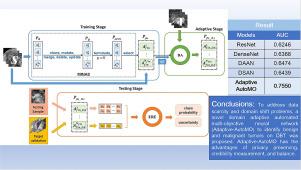Adaptive-AutoMO: A domain adaptive automated multiobjective neural network for reliable lesion malignancy prediction via digital breast tomosynthesis
IF 4.5
2区 医学
Q2 COMPUTER SCIENCE, INTERDISCIPLINARY APPLICATIONS
引用次数: 0
Abstract
Early diagnosis of breast cancer remains a significant global health challenge, and the potential use of deep learning in Digital Breast Tomosynthesis (DBT) based breast cancer diagnosis is a promising avenue. To address data scarcity and domain shift problems in building a lesion malignancy predictive model, we proposed a domain adaptive automated multiobjective neural network (Adaptive-AutoMO) for reliable lesion malignancy prediction via DBT. Adaptive-AutoMO addresses three key challenges simultaneously, they are: privacy preserving, credibility measurement, and balance, which consists of training, adaptation and testing stages. In the training stage, we developed a multiobjective immune neural architecture search algorithm (MINAS) to generate a Pareto-optimal model set with balanced sensitivity and specificity and introduced a Bayesian optimization algorithm to optimize the hyperparameters. In the adaptation stage, a semi-supervised domain adaptive feature network based on maximum mean discrepancy (MMD-SSDAF) was designed, which can make the balanced models adaptable to the target domain and preserve the data privacy in the source domain. In the testing stage, we proposed an evidence reasoning method based on entropy (ERE) that can fuse multiple adapted models and estimate uncertainty to improve the model credibility. The experiments on two DBT image datasets (source and target domain datasets) revealed that Adaptive-AutoMO outperformed ResNet-18, DenseNet-121, and other available domain adaptive models. Meanwhile, the removal of high uncertainty samples resulted in a performance improvement in the target domain. These experiments affirmed that Adaptive-AutoMO can not only enhance model’s performance, but also preserve privacy in the source domain data, boost model credibility, and achieve a balance between sensitivity and specificity.

自适应- automo:一种领域自适应自动多目标神经网络,用于通过数字乳房断层合成可靠的病变恶性预测。
乳腺癌的早期诊断仍然是一个重大的全球健康挑战,深度学习在基于数字乳腺断层合成(DBT)的乳腺癌诊断中的潜在应用是一个很有前途的途径。为了解决构建病变恶性预测模型中存在的数据稀缺和领域漂移问题,提出了一种基于DBT的领域自适应自动化多目标神经网络(adaptive - automo),用于可靠的病变恶性预测。Adaptive-AutoMO同时解决了三个关键挑战,它们是:隐私保护、可信度测量和平衡,包括训练、适应和测试阶段。在训练阶段,我们开发了一种多目标免疫神经结构搜索算法(MINAS)来生成灵敏度和特异性平衡的pareto最优模型集,并引入贝叶斯优化算法来优化超参数。在自适应阶段,设计了一种基于最大平均差异的半监督域自适应特征网络(MMD-SSDAF),使平衡模型能够适应目标域,并保持源域数据的隐私性。在测试阶段,我们提出了一种基于熵的证据推理方法,该方法可以融合多个自适应模型并估计不确定性,以提高模型的可信度。在两个DBT图像数据集(源域数据集和目标域数据集)上的实验表明,adaptive - automo优于ResNet-18、DenseNet-121和其他可用的域自适应模型。同时,去除高不确定度的样本,提高了目标域的性能。实验证明,Adaptive-AutoMO不仅可以提高模型的性能,还可以保护源域数据的隐私性,提高模型的可信度,并在敏感性和特异性之间取得平衡。
本文章由计算机程序翻译,如有差异,请以英文原文为准。
求助全文
约1分钟内获得全文
求助全文
来源期刊

Journal of Biomedical Informatics
医学-计算机:跨学科应用
CiteScore
8.90
自引率
6.70%
发文量
243
审稿时长
32 days
期刊介绍:
The Journal of Biomedical Informatics reflects a commitment to high-quality original research papers, reviews, and commentaries in the area of biomedical informatics methodology. Although we publish articles motivated by applications in the biomedical sciences (for example, clinical medicine, health care, population health, and translational bioinformatics), the journal emphasizes reports of new methodologies and techniques that have general applicability and that form the basis for the evolving science of biomedical informatics. Articles on medical devices; evaluations of implemented systems (including clinical trials of information technologies); or papers that provide insight into a biological process, a specific disease, or treatment options would generally be more suitable for publication in other venues. Papers on applications of signal processing and image analysis are often more suitable for biomedical engineering journals or other informatics journals, although we do publish papers that emphasize the information management and knowledge representation/modeling issues that arise in the storage and use of biological signals and images. System descriptions are welcome if they illustrate and substantiate the underlying methodology that is the principal focus of the report and an effort is made to address the generalizability and/or range of application of that methodology. Note also that, given the international nature of JBI, papers that deal with specific languages other than English, or with country-specific health systems or approaches, are acceptable for JBI only if they offer generalizable lessons that are relevant to the broad JBI readership, regardless of their country, language, culture, or health system.
 求助内容:
求助内容: 应助结果提醒方式:
应助结果提醒方式:


